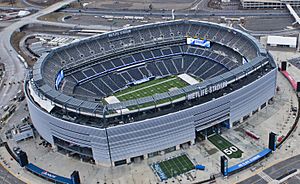New York Giants facts for kids
Quick facts for kids New York Giants |
|||||||||||||
|---|---|---|---|---|---|---|---|---|---|---|---|---|---|
|
|||||||||||||
| Basic info | |||||||||||||
| Established | August 1, 1925 | ||||||||||||
| Stadium | MetLife Stadium, East Rutherford, New Jersey |
||||||||||||
| Headquartered | Quest Diagnostics Training Center, East Rutherford, New Jersey |
||||||||||||
| Colors | Dark blue, red, white |
||||||||||||
| Personnel | |||||||||||||
| Owner(s) |
|
||||||||||||
| Chairman | Steve Tisch | ||||||||||||
| President | John Mara | ||||||||||||
| General manager | Joe Schoen | ||||||||||||
| Head coach | Brian Daboll | ||||||||||||
| Nicknames | |||||||||||||
|
|||||||||||||
| Team history | |||||||||||||
|
|||||||||||||
| Home fields | |||||||||||||
|
|||||||||||||
| League / conference affiliations | |||||||||||||
National Football League (1925–present)
|
|||||||||||||
| Championships | |||||||||||||
League championships: 8
|
|||||||||||||
Conference championships: 11
|
|||||||||||||
Division championships: 16
|
|||||||||||||
| Playoff appearances (33) | |||||||||||||
|
|||||||||||||
| Owner(s) | |||||||||||||
|
|||||||||||||
The New York Giants are a professional American football team. They play in the National Football League (NFL) as part of the National Football Conference (NFC) East division. The team plays its home games at MetLife Stadium in East Rutherford, New Jersey. This stadium is about 5 miles (8 km) west of New York City. The Giants share their stadium with the New York Jets. Their main offices and practice fields are also in New Jersey.
The Giants joined the NFL in 1925. They are the only team from that original group still playing today. They are also the oldest NFL team in the Northeastern United States. The Giants have won eight NFL championship titles. Four of these were before the Super Bowl era (1927, 1934, 1938, 1956). They have also won four Super Bowls (XXI in 1986, XXV in 1990, XLII in 2007, and XLVI in 2011). Only the Green Bay Packers (13) and Chicago Bears (9) have won more championships. Many Giants players have been inducted into the Pro Football Hall of Fame. These include NFL Most Valuable Player (MVP) winners like Mel Hein and Lawrence Taylor.
To tell them apart from a baseball team with the same name, the football team was officially called the "New York Football Giants" in 1937. Even though the baseball team moved to San Francisco, the football team still uses this name. Fans and sportscasters often call them "Big Blue" or the "G-Men." Their strong rivalry with the Philadelphia Eagles is the oldest in the NFC East. It started in 1933 and is known as one of the best rivalries in the NFL.
Contents
- Team History and Achievements
- Championships and Titles
- Team Look: Logos and Uniforms
- Team Ownership and Fans
- Team Rivalries
- Giants Players
- Coaches
- Media and Broadcasts
- Images for kids
- See also
Team History and Achievements
Early Years and First Championships (1925–1953)
The New York Football Giants team was started on August 1, 1925, by Timothy Mara. The cost to create the team was $2,500. The Giants played their first game on October 4, 1925, winning 26–0 against a non-NFL team. Their first official NFL game was a week later, which they lost. However, the Giants had a good first season, finishing with an 8–4 record.
In their third season, the Giants had the best record in the league (11–1–1) and won the NFL title. After a less successful 1928 season, owner Tim Mara bought the entire team of the Detroit Wolverines. This brought star quarterback Benny Friedman to the Giants.
In 1930, the Giants played a special game against a team of Notre Dame All-Stars. This game helped show how good professional football was. The Giants won easily, and the game helped make pro football more popular.
From 1931 to 1947, the Giants played in the NFL championship game eight times, winning twice. During this time, they were led by Hall of Fame coach Steve Owen. Famous players like Mel Hein and Tuffy Leemans also played for them. In 1933, they lost the championship to the Chicago Bears.
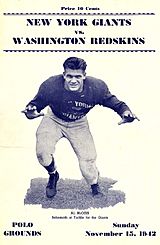
Winning the "Sneakers Game" (1934)
The Giants won their second NFL championship in 1934 in a famous game called the "Sneakers Game." They beat the Chicago Bears on an icy field by wearing sneakers for better grip. The next year, they lost the championship to the Detroit Lions.
Third NFL Title (1938)
The Giants won their third NFL championship in 1938, beating the Green Bay Packers 23–17. Both teams met again in the 1939 championship, where the Packers won. The 1944 Giants team was known for its amazing defense, giving up very few points.
The Glory Years and "The Greatest Game Ever Played" (1954–1960)
The Giants won their next championship in 1956. This was the first year they played at Yankee Stadium in New York City. Key players included Frank Gifford, Sam Huff, and Roosevelt Brown. Their coaching staff was also legendary, with Vince Lombardi coaching offense and Tom Landry coaching defense.
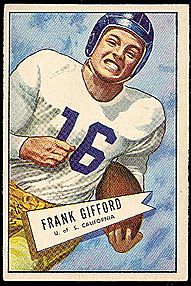

From 1958 to 1963, the Giants played in the NFL Championship Game five times but did not win. The 1958 NFL Championship Game against the Colts is often called "The Greatest Game Ever Played." The Giants lost in overtime, but this game greatly increased the NFL's popularity.
Challenges and a New Home (1961–1982)
The Giants lost two more championship games to the Green Bay Packers in 1961 and 1962. In 1963, led by MVP quarterback Y. A. Tittle, they lost another championship to the Bears.
From 1964 to 1978, the Giants had only two winning seasons and no playoff appearances. The team struggled, and they even had a very bad 1–12–1 record in 1966. They played home games at different stadiums, including the Yale Bowl and Shea Stadium, before moving into their own Giants Stadium in East Rutherford, New Jersey, in 1976.

A low point was the "Miracle at the Meadowlands" in 1978. The Giants were trying to run out the clock to win, but quarterback Joe Pisarcik fumbled the ball. An Eagles player, Herman Edwards, picked it up and ran for a game-winning touchdown.
The Giants' management faced challenges during this time. To help the team run better, NFL Commissioner Pete Rozelle appointed George Young as general manager. This helped the team improve. In 1979, the Giants started to rebuild by drafting quarterback Phil Simms and linebacker Lawrence Taylor. In 1981, Taylor won Defensive Rookie of the Year, and the Giants made the playoffs for the first time since 1963.
The Bill Parcells Era and Super Bowl Wins (1983–1990)
In 1983, Bill Parcells became the head coach. After a tough first season, the team improved. They won nine games in 1984 and made the playoffs.
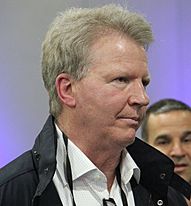

Super Bowl XXI Champions (1986)
In 1986, the Giants had an amazing 14–2 record. This was their best regular season record since the NFL started playing 16-game seasons. They were led by MVP Lawrence Taylor and their strong defense, known as the "Big Blue Wrecking Crew." The Giants won their playoff games and reached their first Super Bowl, Super Bowl XXI, against the Denver Broncos. Quarterback Phil Simms had a record-setting performance, completing 88% of his passes. The Giants defeated the Broncos 39–20, winning their first championship since 1956.
After their Super Bowl win, the Giants had some ups and downs. In 1989, they had a 12–4 record but lost in the playoffs.
Super Bowl XXV Champions (1990)
In 1990, the Giants had a 13–3 record. They set an NFL record for the fewest turnovers in a season. They defeated the San Francisco 49ers in a close game and then beat the Buffalo Bills 20–19 in Super Bowl XXV, winning their second Super Bowl.
Modern Era and More Super Bowl Victories (1991–Present)
After the 1990 season, Bill Parcells left as head coach. The team had a few challenging seasons. In 1993, with new coach Dan Reeves, the Giants had a good season, and stars like Phil Simms and Lawrence Taylor finished their careers on a playoff team.
The Giants struggled again in the mid-1990s. In 1997, Jim Fassel became head coach. The team made the playoffs that year but lost in the first round. In 1999, the Giants signed quarterback Kerry Collins.
NFC Champions (2000)
In 2000, the Giants started strong and finished the season 12–4. Coach Fassel famously guaranteed the team would make the playoffs. They won their playoff games, including a 41–0 victory over the Minnesota Vikings in the NFC Championship. They went on to play the Baltimore Ravens in Super Bowl XXXV, but lost 34–7.
After a tough 2003 season, Jim Fassel was replaced by Tom Coughlin in 2004. That year, the Giants also traded for quarterback Eli Manning, who became the team's starter.
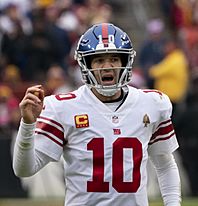
Super Bowl XLII Champions (2007)
In 2007, the Giants made the playoffs for the third straight season. They played a historic game in London, England, beating the Miami Dolphins. The Giants finished 10–6 and won three road playoff games to become NFC Champions. They faced the undefeated New England Patriots in Super Bowl XLII. The Patriots were heavily favored, but the Giants pulled off a huge upset, winning 17–14. A key play was the "Manning to Tyree" pass, where David Tyree caught the ball against his helmet. This win is considered one of the biggest upsets in Super Bowl history.
In 2008, the Giants started 11–1 but lost some games late in the season. They still won their division but lost in the playoffs. In 2009, the Giants moved into a new training complex. In 2010, they moved into MetLife Stadium. They had a tough loss to the Eagles in 2010, known as the "Miracle at the New Meadowlands."
Super Bowl XLVI Champions (2011)
The 2011 season saw the rise of new stars like wide receiver Victor Cruz. The Giants had an up-and-down season but won their last two games to clinch the NFC East division title. In the playoffs, they defeated the Atlanta Falcons and then upset the top-ranked Green Bay Packers. They then won the NFC Championship against the San Francisco 49ers in overtime.
The New York Giants won Super Bowl XLVI against the New England Patriots, 21–17. Eli Manning was named Super Bowl MVP for the second time. The Giants are the only NFL team to have more than two second-half, come-from-behind Super Bowl victories.
The Giants missed the playoffs in 2012, 2013, 2014, and 2015. In 2013, they hoped to be the first team to play in a Super Bowl in their home stadium, but they started the season with six losses. In 2014, they drafted wide receiver Odell Beckham Jr., who won Offensive Rookie of the Year.
Recent Seasons (2016–Present)
In 2016, Ben McAdoo became the new head coach. The Giants improved to an 11–5 record and made the playoffs, ending a five-year drought. However, they lost in the first round to the Green Bay Packers.

The 2017 season was difficult, with a 3–13 record. Key players like Odell Beckham Jr. suffered season-ending injuries. Coach Ben McAdoo and general manager Jerry Reese were fired during the season. The team then drafted running back Saquon Barkley in 2018, who had an excellent rookie season.
In 2019, the Giants drafted quarterback Daniel Jones. Longtime quarterback Eli Manning retired after 16 seasons. The team finished 4–12. Joe Judge was hired as head coach for the 2020 season, where the Giants finished 6–10. In 2021, they finished 4–13, leading to the hiring of Joe Schoen as general manager and Brian Daboll as head coach in 2022.
The 2022 season showed great improvement, with a 9–7–1 record. The Giants made the playoffs for the first time since 2016. They defeated the Minnesota Vikings in the wild-card round, their first playoff win since Super Bowl XLVI. They then lost to the Philadelphia Eagles in the divisional round.
In the 2023 season, the Giants finished 6–11. Daniel Jones was injured, and Tyrod Taylor and Tommy DeVito played quarterback. The 2024 season was also challenging, with a 3–14 record. Daniel Jones was released during the season. Rookie wide receiver Malik Nabers broke team and NFL rookie records for receptions. In the 2025 NFL Draft, the Giants selected edge rusher Abdul Carter.
Championships and Titles
The Giants have won eight league championships in total. Four were before the Super Bowl era, and four were Super Bowls. Their eight championships rank them third among all NFL teams.
NFL Championships (Pre-Super Bowl Era)
The Giants won four NFL championships before the Super Bowl was created.
| Year | Coach | Location | Opponent | Score | Record |
|---|---|---|---|---|---|
| 1927 | Earl Potteiger | N/A | N/A | N/A | 11–1–1 |
| 1934 | Steve Owen | New York, NY | Chicago Bears | 30–13 | 8–5 |
| 1938 | Green Bay Packers | 23–17 | 8–2–1 | ||
| 1956 | Jim Lee Howell | Bronx, NY | Chicago Bears | 47–7 | 8–3–1 |
| Total NFL championships won: | 4 | ||||
Super Bowl Championships
The Giants have won four Super Bowls. This ties them for fifth most in the NFL.
| Year | Coach | Super Bowl | Location | Opponent | Score | Record |
|---|---|---|---|---|---|---|
| 1986 | Bill Parcells | XXI | Rose Bowl (Pasadena) | Denver Broncos | 39–20 | 17–2 |
| 1990 | XXV | Tampa Stadium (Tampa) | Buffalo Bills | 20–19 | 16–3 | |
| 2007 | Tom Coughlin | University of Phoenix Stadium (Glendale) | New England Patriots | 17–14 | 14–6 | |
| 2011 | Lucas Oil Stadium (Indianapolis) | New England Patriots | 21–17 | 13–7 | ||
| Total Super Bowls won: | 4 | |||||
NFC Championships
The Giants have won five NFC Championship Games. Two of these wins were in overtime.
| Year | Coach | Location | Opponent | Score | Record |
|---|---|---|---|---|---|
| 1986 | Bill Parcells | East Rutherford, NJ | Washington Redskins | 17–0 | 17–2 |
| 1990 | San Francisco, CA | San Francisco 49ers | 15–13 | 16–3 | |
| 2000 | Jim Fassel | East Rutherford, NJ | Minnesota Vikings | 41–0 | 14–5 |
| 2007 | Tom Coughlin | Green Bay, WI | Green Bay Packers | 23–20 (OT) | 14–6 |
| 2011 | San Francisco, CA | San Francisco 49ers | 20–17 (OT) | 13–7 | |
| Total NFC Championships won: | 5 | ||||
Team Look: Logos and Uniforms

The Giants have used many different uniforms and logos over their long history. Their logos have included a giant quarterback and a small "ny" design.
Giants jerseys are usually blue or red, with white accents. Their pants are either white or gray. Their home uniform is blue with white numbers and blue/gray/red stripes on the pants. This is why they are called "Big Blue." Their road uniform is white with red numbers and red/blue/red stripes on gray pants.
The Giants' helmet is metallic blue with white numbers on the front and back. They are one of only two NFL teams to have numbers on both sides of their helmets. The helmet also has a white "ny" logo and a gray facemask.
Team Ownership and Fans
The Giants were founded by Tim Mara in 1925 with a small investment. To avoid confusion with a baseball team, they called themselves the "New York Football Giants."
Early on, professional football was not very popular. The Giants struggled financially until a game against Red Grange and the Chicago Bears in 1925. Over 73,000 fans showed up, which brought much-needed money to the team.
The Giants' financial situation improved over time. In the 1960s, the Mara family pushed for all NFL teams to share television revenue equally. This helped make the league stronger.
In 1991, Tim Mara's grandson sold his share of the team to Bob Tisch. This was the first time the team was not fully owned by the Mara family. Today, the Giants are owned and run by John Mara and Steve Tisch.
In 2010, MetLife Stadium opened. The Giants and Jets built this stadium together using private money. This stadium replaced Giants Stadium.
The Giants have a large fan base in the New York metropolitan area. Even after moving to New Jersey, many fans from New York still support them. In 2008 and 2012, New York City held parades to celebrate the Giants' Super Bowl victories. The Giants also have a very long waiting list for season tickets, showing how dedicated their fans are.
Team Rivalries
The Giants have several strong rivalries, especially within their division.
Divisional Rivals
Philadelphia Eagles
The rivalry with the Philadelphia Eagles is one of the oldest in the NFL, starting in 1933. Both teams often compete for playoff spots and division titles. The Eagles currently lead the all-time series. They have met five times in the playoffs, with the Eagles winning three of those games.
Washington Commanders
The Giants also have a long rivalry with the Washington Commanders. In the 1980s, these teams often battled for division titles. A notable game was the 1986 NFC Championship, where the Giants beat the Redskins 17–0. The Giants lead this series with the most wins against a single opponent in NFL history.
Dallas Cowboys
The rivalry with the Dallas Cowboys started in 1960. Both teams have won many Super Bowls and often play important games for the NFC East title. The Cowboys lead the regular season series, but the Giants won their only playoff meeting in 2007.
Conference Rivals
San Francisco 49ers
Even though they are not in the same division, the Giants and San Francisco 49ers have a strong rivalry. They have played eight times in the playoffs since 1982. The winner of their playoff games has often gone on to win the Super Bowl.
Interconference Rivals
New York Jets
The Giants and New York Jets share a stadium and have a unique rivalry. They play each other every year in the preseason. Regular season games happen less often, only every four years. In 1988, the Jets stopped the Giants from making the playoffs. In 2011, the Giants beat the Jets, which helped the Giants make the playoffs and win Super Bowl XLVI.
New England Patriots
The rivalry between the Giants and New England Patriots became famous in the late 2000s. They played two memorable Super Bowls. In 2007, the Patriots had a perfect regular season, but the Giants defeated them in Super Bowl XLII. The Giants also beat the Patriots in Super Bowl XLVI.
Historic Rivals
Chicago Bears
The Giants and Chicago Bears played in six NFL championship games, more than any other matchup. The Bears won four of these, but one of the Giants' wins was the famous "Sneakers Game" in 1934.
Green Bay Packers
The Giants and Green Bay Packers have a long history of playing each other. They are both in the National Football Conference. The Packers lead the all-time series, including playoff games.
Giants Players
Current Roster
|
New York Giants roster
|
|||||||||
|---|---|---|---|---|---|---|---|---|---|
Quarterbacks
Running backs
Wide receivers
Tight ends
|
Offensive linemen
Defensive linemen
|
Linebackers
Defensive backs
Special teams
|
Reserve lists
→ AFC rosters → NFC rosters |
||||||
Retired Numbers
The Giants have retired several jersey numbers to honor their greatest players.
| New York Giants retired numbers | ||||
| No. | Player | Position | Career | Retired |
|---|---|---|---|---|
| 1 | Ray Flaherty 1 | E | 1928–1935 | 1935 |
| OT | 1930–1937 | 1938–1966 | ||
| 4 | Tuffy Leemans | RB | 1936–1943 | 1940 |
| 7 | Mel Hein | C, LB | 1931–1945 | 1963 |
| 10 | Eli Manning | QB | 2004–2019 | September 26, 2021 |
| 11 | Phil Simms | QB | 1979–1993 | September 4, 1995 |
| 14 | Ward Cuff 4 | HB, WB | 1937–1945 | 1946 |
| Y. A. Tittle 4 | QB | 1961–1964 | 1965 | |
| 16 | Frank Gifford | HB, WR | 1952–1964 | October 19, 2000 |
| 32 | Al Blozis 3 | OT | 1942–1944 | 1945 |
| 40 | Joe Morrison | RB, WR | 1959–1972 | 1972 |
| 42 | Charlie Conerly | QB | 1948–1961 | 1962 |
| 50 | Ken Strong | HB | 1933–1947 | 1947 |
| 56 | Lawrence Taylor | LB | 1981–1993 | October 11, 1994 |
| 92 | Michael Strahan | DE | 1993–2007 | November 28, 2021 |
- Notes:
- 1 This was the first number retired in professional football. It was unretired in 2024 for Malik Nabers with permission from the Flaherty family.
- 2 The Giants retired #3 for Len Grant, who died in 1938. It was put back into use in 1966.
- 3 Honored after their death.
- 4 Number 14 was retired for Ward Cuff, then for Y. A. Tittle. It is now retired for both players.
Pro Football Hall of Famers
The Giants have the second-highest number of players in the Pro Football Hall of Fame, with 29 members. Some famous Giants in the Hall of Fame include Tim Mara, Mel Hein, Frank Gifford, Lawrence Taylor, and Michael Strahan.
Ring of Honor
The New York Giants started their Ring of Honor in 2010 to celebrate players, coaches, and owners who made a big impact. The first group included 30 people, such as Phil Simms, Bill Parcells, Michael Strahan, Tiki Barber, and Frank Gifford.
NFL MVP Award Winners
Six Giants players have won the NFL MVP award:
| Giants NFL MVP winners | |||
| Year | Player | Position | Selector |
|---|---|---|---|
| 1938 | Mel Hein | C, LB | NFL |
| 1956 | Frank Gifford | HB, WR | NEA, UPI |
| 1959 | Charlie Conerly | QB | NEA |
| 1961 | Y. A. Tittle | QB | NEA |
| 1962 | Y. A. Tittle | QB | UPI |
| 1963 | Y. A. Tittle | QB | AP, NEA |
| 1986 | Lawrence Taylor | LB | AP, PFWA |
| Phil Simms | QB | NEA | |
Super Bowl MVP Award Winners
Three Giants players have won the Super Bowl MVP award:
| Super Bowl MVP winners | ||
| Super Bowl | Player | Position |
|---|---|---|
| XXI | Phil Simms | QB |
| XXV | Ottis Anderson | RB |
| XLII | Eli Manning | QB |
| XLVI | ||

Coaches
The Giants have had 22 head coaches in their history.
Current Coaching Staff
|
→ Coaching staff |
|||||
Media and Broadcasts
The Giants' main radio station is WFAN. You can hear games on both WFAN-AM and WFAN-FM. Bob Papa does the play-by-play, and Carl Banks provides commentary.
Preseason games that are not shown nationally are broadcast on WNBC. WPIX-TV or WABC-TV also show Giants games that are only on ESPN. Games streamed on Amazon Prime Video are also shown on WNYW.
Images for kids
-
Hall of Fame OT Rosey Brown
-
Hall of Fame LB Harry Carson
-
Hall of Fame HB Frank Gifford
-
Hall of Fame DE Michael Strahan
-
Hall of Fame QB Y.A. Tittle
-
Hall of Fame DB Emlen Tunnell
See also
 In Spanish: New York Giants para niños
In Spanish: New York Giants para niños






